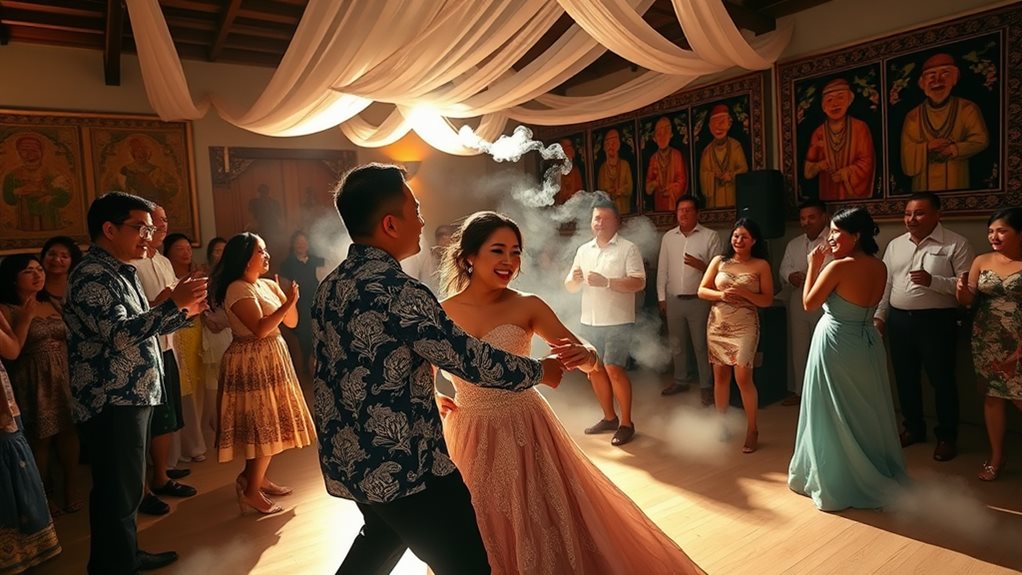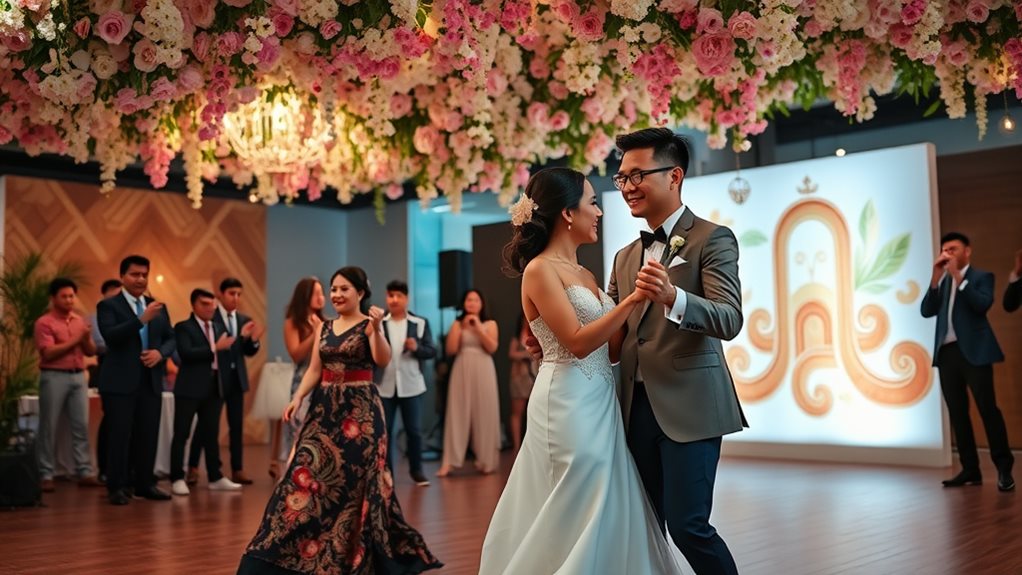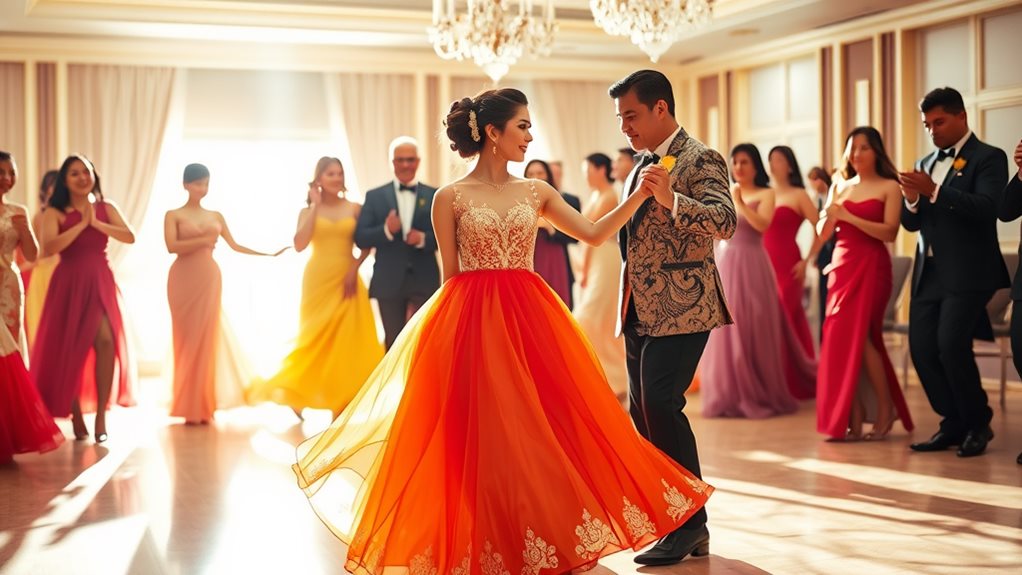You experience a dynamic fusion of Tinikling rhythms and hip-hop beats at modern Filipino weddings, seamlessly blending cultural heritage with contemporary styles. Traditional dances like Pandanggo sa Ilaw and Itik-Itik become vibrant then-contemporary choreographed performances. Guest participation in Money Dance adds a modern twist, while professional dancers enhance the spectacle. Cultural significance and community ties remain strong, reflecting unique identities through timeless and evolving elements. If you explore further, you'll uncover more about the intricate balance between tradition and innovation in these celebrations.
Historical Roots

Starting from the earliest traditions of the islands, one can trace a rich tapestry of communal dancing in pre-colonial Filipino wedding celebrations, where every step and rhythm carried profound cultural meaning and storytelling.
These dances, deeply rooted in your cultural heritage, reflected the close connection to nature and community. Historical roots expose how traditional folk dances, such as the Tinikling and Pandanggo sa Ilaw, were integrated into wedding ceremonies, symbolizing joy and the unity of families.
With the onset of Spanish colonization, these ancient practices intertwined with European influences, introducing formal ballroom styles that highlighted social status and elegance.
Your modern Filipino weddings now preserve these historical roots while embracing contemporary styles, blending traditional folk dances with modern music and choreography, allowing younger generations to celebrate cultural heritage through vibrant, dynamic performances.
Pre-Wedding Rituals
Amidst the vibrant dance of traditions in your wedding celebrations, the preparatory rituals of today's Filipino weddings play a pivotal role in strengthening family and community bonds, much like the historical dances once did.
The Pamamanhikan, a formal pre-wedding ritual, brings the groom's family to the bride's home to formally ask for her hand, discuss wedding plans, and cement familial bonds. This act is closely followed by the Paalam ceremony, marking the groom's commitment to his future spouse and her family.
The Despedida de Soltera, a farewell party celebrating your transition into married life, gathers close family and friends, serving as a symbolic step into the new phase of your life.
In the Pamanhikan sa Simbahan, both parties visit the church to meet with the officiant and finalize wedding arrangements, emphasizing your religious commitment.
Community involvement throughout these rituals underscores the collective support and shared experiences central to cultural heritage and wedding traditions.
Traditional Dances

In your wedding celebrations, traditional Filipino dances like Tinikling and Itik-Itik offer a dynamic glimpse into your rich cultural heritage, with each step and gesture mirroring the community's unity and the couple's joy.
Performing Tinikling, you witness agile teamwork as dancers step rhythmically between clapping bamboo poles, a symbol of adaptability and community bonds.
Itik-Itik, a folk dance imitating duck movements, adds fun and grace during wedding festivities, often engaging bridesmaids or flower girls.
The Money Dance further enriches these celebrations, with guests pinning monetary support onto you and your partner, enhancing the honoring of Filipino cultural identity.
These traditional dances aren't just performances but meaningful rituals that strengthen ties and celebrate your union with authenticity and celebration.
Contemporary Styles
Modern Filipino wedding dances often blend a myriad of contemporary styles like hip-hop and jazz, allowing you to express personal flair while honoring your cultural roots. The traditional Money Dance has evolved, with modern music and choreography enhancing the experience for guests. Couples showcase heritage by blending folk dances with contemporary routines, attracting younger audiences. Choreographed dance performances by the bridal party add to the entertainment, fostering a lively atmosphere. Interactive dance segments invite guests to participate in popular trends, enhancing camaraderie.
| Traditional Element | Contemporary Twist | Cultural Significance |
|---|---|---|
| Money Dance | Modern music & choreography | Engages guests with vibrant, personalized entertainment |
| Tinikling, Itik-Itik | Mixed with hip-hop, jazz | Highlights heritage while appealing to a modern audience |
| Bridal Party | Choreographed performances | Enhances celebration, promotes unity and joy |
| Guest Interaction | Popular dance segments | Fosters camaraderie, makes attendees feel involved and valued |
| Personal Expression | Adaptable dance styles | Allows couples to showcase individuality while staying true to heritage |
Fusion Performances

Fusion performances at Filipino weddings transform traditional dances like Tinikling and Itik-Itik into vibrant spectacles by blending them with contemporary music styles, creating an atmosphere that celebrates both your heritage and the modern spirit.
By hiring professional dancers, you bring a level of expertise that combines cultural heritage with innovative choreographed dance routines featuring hip-hop, jazz, or popular tunes. This not only keeps the wedding dynamic and engaging but also highlights the diverse and rich history of Filipino traditions.
Interactive segments offer opportunities for guests to participate actively, enhancing their experience through community and celebration, all while maintaining a connection to the cultural storytelling embedded in each dance.
Integrating these elements ensures that your wedding resonates with everyone, celebrating your unique identity through a blend of timeless and current aesthetics.
Community Involvement
By weaving together traditional dances with contemporary beats, your guests become part of a dynamic celebration that honors both heritage and innovation.
Community involvement is integral to Filipino weddings, where family and friends actively participate in preparation tasks like cooking and decorating.
During the wedding reception, traditional practices such as the Money Dance encourage financial contributions, fostering a sense of shared responsibility for the couple.
The Pamamanhikan, a formal meeting between families, reinforces community connections and unity, symbolizing the endorsement of family values.
Guests often bring traditional dishes, showcasing culinary heritage and promoting community through shared meals that highlight local flavors.
- Strengthen familial bonds and social ties through active participation.
- Reinforce community connections and unity during the Pamamanhikan.
- Foster a sense of collective responsibility and support for the newlyweds through traditional practices.
Symbolic Ceremonies

A ceremony woven with deep symbolic meaning, the Arras, Veil and Cord, and Unity Candle rituals bring together hearts and spirits, sealing eternal vows with gestures rich in tradition.
During the Arras ceremony, you exchange 13 gold or silver Arras coins, symbolizing your commitment to providing for the family and reflecting mutual partnership. This act not only honors Filipino heritage but also strengthens family ties through tangible expressions of support.
The Veil and Cord ceremony then follows, as a veil is placed over both you and your partner, symbolizing unity and protection, with the cord securing your bond and illustrating your spiritual and emotional alignment.
In the Unity Candle ritual, guiding lights are lit, representing the merging of two lives and families into one, symbolizing a shared future.
Principal and Secondary Sponsors play crucial roles, offering blessings and prayers that reinforce the unity and strengthen your connection with the community around you.
Traditional elements like sweeping coins after the Arras ceremony not only add cultural depth but also underscore the belief in prosperity and partnership, emphasizing your dedication to building a successful marriage.
Sustainable Practices
After honoring your commitment and the spiritual bond through the Arras, Veil and Cord, and Unity Candle rituals, you may want to consider the environmental impact of your wedding.
Embracing sustainable practices not only benefits the planet but also aligns with a deeper cultural respect for nature. Choose eco-friendly decorations using biodegradable materials and locally sourced flowers to add a touch of Filipino craftsmanship.
Opt for digital invitations to minimize paper waste, and in catering, select organic food to support local farmers while reducing your carbon footprint.
Ethically-made wedding attire that reflects traditional values while adhering to sustainable standards is another way to integrate cultural and ecological consciousness.
Green certifications and natural settings for venues ensure that your wedding space promotes sustainability and beauty in harmony.
- Reflecting on your role in reducing environmental impact
- Celebrating cultural heritage through ethical and sustainable choices
- Supporting local communities and ecosystems with your wedding plans
Questions and Answers
What Is the Dance of Filipino Wedding Traditions?
The dance of Filipino wedding traditions embodies celebration themes through wedding rituals, cultural significance, folk dances, and song selections, varying regionally with modern interpretations encouraging guest participation and diverse choreography styles.
What Is Traditional Vs Contemporary Wedding?
Traditional vs contemporary weddings balance cultural significance with modern influences, blending wedding rituals, music selection, and dance styles while evolving attire, family involvement, celebration themes, reception activities, and guest participation across generations.
What Is the Filipino Wedding Coin Tradition?
The Filipino wedding coins symbolize financial stewardship, with historical roots in religious significance. Modern interpretations blend tradition, emphasizing shared responsibilities and familial support.
What Is Traditional Filipino Wedding Attire?
Exploring traditional Filipino wedding attire, you wear a barong tagalog history-infused groom's shirt. You choose between a Maria Clara gown or a terno dress, both symbolizing grace. Symbolism of fabrics like piña speaks to heritage, while modern twists, regional styles, vibrant colors, cultural attire variations, and elaborate accessories flourish, sharing significance with guests.